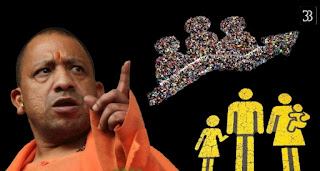POPULATION CONTROL BILL IN UTTAR PRADESH
Uttar Pradesh, the most populous state in the country, could soon have a two-child policy aiming to encourage people to have small families. The UP State Law Commission has started work on a draft bill to bring legislation, which could propose to limit the benefits of state schemes only to those with two children or fewer while the UP government has not made any announcement in this regard yet. Justice (retired) Aditya Nath Mittal, the law commission chief confirmed that they have begun the groundwork and discussion to prepare the draft bill. Assam is also planning a similar policy, with Chief Minister Himanta Biswa recently announcing that his government would gradually implement the two-child norm for availing benefits under a specific scheme funded by the state. The reason for bringing such a law, Justice Mittal said: “Population control is a necessity, UP has more than 22 crore population, which is higher than many countries. So it’s necessary that at some point in time, one should take measures.”
However, several states including Assam, Maharashtra, Odisha, Rajasthan, Telangana, and Andhra Pradesh already have some form of the two-child norms in place for those running for elected government posts or government jobs.

BENEFITS BY UTTAR PRADESH GOVERNMENT
The Law is aimed at incentivizing people to help in population control in the most populous state in the country. Speaking to Economic Times, Chairman of the UP State Commission, AN Mittal, said the draft law which will be prepared in two months after consultations with the relevant stakeholders, factoring in public opinion, etc, will be aimed at state government programs like subsidies on certain products and services, ration distribution, employment in state government services, and other state welfare scheme like affordable housing schemes. A cut-off date will be decided for its implementation, Mittal said. The law will be implemented prospectively and not retrospectively, he said adding that the nine-month pregnancy room will also be factored in while deciding the cut-off data. He also said that the state’s population is nearing an explosive stage and there should be a check on the rising population so that people can get government facilities and resources. Mittal said “We want that our future generation gets the best education, best treatment at hospitals, can study in the best school, can consume a nutritious diet, etc. It is a matter of social concern.”

CRITICISM OF THE TWO-CHILD POLICY
The restricted child policy will create a shortage of educated young people needed to carry on India’s technological revolution. The problems like gender imbalance, undocumented children, etc faced by China (as a result of the one-child policy) might be experienced by India also. India’s birthrate is slowing down to sustainable levels. In 2000 the fertility rate was still relatively high 3.2 children per woman. By 2016, that number had already fallen to 2.3 children. Many critics have argued that the population growth in India naturally goes on the path of a declining trajectory as the country is becoming more educated. A significant proportion of rural women especially those from lower socio-economic strata, would be forced to go for unsafe abortions because of issues of access and affordability.
CONCLUSION
- Though this initiative has both positive and negative aspects, it is a necessity at this hour. If executed, the impacts would be positive the government schemes would be implemented more efficiently, availability of natural resources for coming generations as well, tax distribution would then be in a very systematic manner, elimination of poverty and misery. Also, the amendment to the constitution is sought in order to empower the citizens of India by limiting family size with the intention to promote self-sufficiency, peace, and harmony

